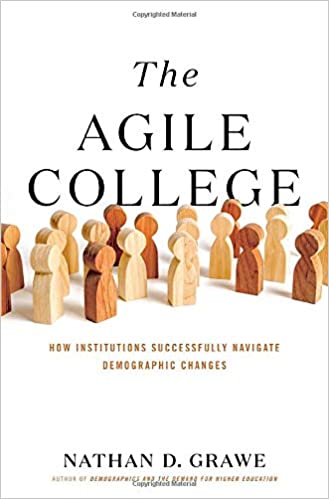‘The Agile College’ and the Adaptive University
 The Agile College: How Institutions Successfully Navigate Demographic Changes by Nathan D. Grawe
The Agile College: How Institutions Successfully Navigate Demographic Changes by Nathan D. Grawe
Published in January of 2021.
Every conversation about the future of higher education in the United States either starts or ends with demographics. And since 2018, that conversation likely included mention of the economist Nathan Grawe.
It was in January of that year when Grawe published Demographics and the Demand for Higher Education. The careful data-driven analysis and non-polemical style of that book, written by someone from within higher education (Grawe is a prof at Carleton College), resulted in Demographics and the Demand for Higher Education being perhaps the most influential academic book of the past few years.
Now Grawe is back with rapid follow-up in the form of The Agile College.
This new book accomplishes two important things.
First, Grawe updates and refines his projections to the mid-2030s. The news, as one would expect, is not good. Beyond a slight blip in demand in the late 2020s, Grawe projects that the trends he explored in his earlier volume will only deepen.
For the three people in higher ed who have not seen Grawe’s forecasts, the gist of his analysis is:
1) There will be a rapid decline in high school graduates across the Northeast and Midwest over the next 15 years due to declining fertility and migration trends, decreasing the demand among traditionally age students, as the vast majority of all college-goers live relatively close to the schools they attend.
2) Colleges and universities with national/global brands will see increased demand for slots as cohorts of parents with postsecondary education increase and look to send their children to these schools.
3) Nationwide demographic trends will result in a much more ethnically diverse set of traditional college-age cohorts. This shift will also pose challenges around the ability of families to meet the rising costs of college attendance.
The Agile College was written before COVID, so the pandemic-related fertility declines are not included in Grawe’s forecasts. What everyone knows is that the pandemic will accelerate – perhaps sharply – the demographic trends that are so worrying to so many of us in higher education.
The second big thing that The Agile College accomplishes is to debunk the idea that colleges and universities are helpless in the face of demographic trends.
In December of 2020, I wrote a piece called The Misuse of Demographics as Justification for Faculty and Staff Cuts. If The Agile College had been available back then, I would have cited it in my piece.
Grawe is at pains to point out that demographic challenges need not equate to an existential threat for institutions of higher education. Knowing about the nation’s shifting demographics does not mean that schools are powerless to act.
What Grawe believes, and where I concur, is that most colleges and universities can’t behave as if tomorrow will be like today. Doing nothing in the face of the demographic projections contained in Grawe’s work is not an option.
In the second half of The Agile College, Grawe offers several paths colleges and universities might investigate. These strategies to respond to demographic trends are derived from case studies of colleges and universities that have been proactive in preparing for what’s coming at us.
Strategies for managing declining demand that Grawe discusses range from:
A) Focussing on retention through innovation.
B) Growing the population of non-traditional learners and non-undergraduate degree programs through online learning.
C) Reducing the size of classes to match demand.
D) An openness to looking at sharing services across institutions or even merging.
Grawe argues that colleges and universities are more agile (hence the book title), creative, and innovative than popularly acknowledged. Higher education is more resilient than its critics imagine. Our success in navigating this pandemic should be evidence of our anti-fragility.
The ideas and case studies presented in The Agile College are a good starting place for conversation, but only a starting place. Grawe is more a student of higher education-related demographic trends than he is a student of higher education. Grawe’s examples of relevant institutional innovations are largely divorced from any broader frameworks for how colleges and universities adapt and evolve.
It is not clear what the variables will be that will determine successful postsecondary evolutionary adaptation.
Is leadership from the top the critical determinant? And if so, where from the top? (Presidents, Provosts, Deans, Trustees?)
What positive and negative roles will non-profit/for-profit partnerships (think OPMs) play in responding to an accelerating set of postsecondary demographic headwinds?
Can faculty and staff have agency in the process of institutional innovation, or are we fated to be whipsawed by a set of exogenous demographic forces that we might understand but can’t influence?
The Agile College should convince all of us in higher ed that, yes, Winter is Coming. But more importantly, this latest edition to the canon of Nathan Grawe should persuade us that the White Walkers of low fertility and wage stagnation, and low in-migration can all met with creative solutions.
We only need to decide to act.
What are you reading?
Published at Tue, 11 May 2021 01:00:00 +0000
Article source: https://www.insidehighered.com/blogs/learning-innovation/%E2%80%98-agile-college%E2%80%99-and-adaptive-university